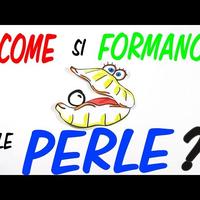Come si formano le PERLE?
Wie werden PEARLS gebildet?
How are the PEARLS formed?
¿Cómo se forman las PERLAS?
Comment se forment les PEARLS ?
Jak powstają PEARLS?
Como são formadas as pérolas?
Как формируются ПЭАРЛС?
Як утворюються перлини?
Sebbene gran parte dei gioielli provenga da pietre preziose e gemme trovate nel sottosuolo,
||||Schmuck|||||||||
|||||||||||||subsoil
avrai sicuramente sentito dire che le brillanti perle provengono dalle ostriche,
||||||||||Austern
||||||||||oysters
e basterebbe aprirle per prelevare il gioiello perfettamente formato, per il nostro uso personale.
||||||Juwel|||||||
||||retrieve|||||||||
and it would be enough to open them to remove the perfectly formed jewel, for our personal use.
Fin qui tutto chiaro ma, perché producono le perle?
حتى الآن كل شيء واضح ولكن لماذا ينتجون اللؤلؤ؟
So far all clear but, why do they produce pearls?
È emerso che le ostriche demoliscano il proprio guscio, creando le perle come risposta immunitaria
|||||demolieren|||||||||
|emerged||||demolish|||shell||||||immune response
لقد وجد أن المحار يقوم بتكسير أصدافه الخاصة، مما يؤدي إلى تكوين اللؤلؤ كاستجابة مناعية
It was found that oysters demolish their shells, creating pearls as an immune response
agli oggetti estranei.
to foreign objects.
Le ostriche sono molluschi bivalvi, che significa che sono composti da due conchiglie, al cui
||||Muscheln||||||||Schalen||
||||bivalve mollusks||||||||||
Oysters are bivalve molluscs, which means they are composed of two shells, to which
interno vi è un organo, il mantello, che rilascia una sostanza chiamata madreperla,
||||||||||||Perlmutt
||||||mantle||||||mother of pearl
inside there is an organ, the mantle, which releases a substance called mother of pearl,
fatta principalmente di carbonato di calcio.
|||carbonate||
made mainly of calcium carbonate.
Questa sostanza è quella che produce le perle, che si formano quando un oggetto esterno,
This substance is what produces pearls, which are formed when an external object,
o un parassita, passa tra il guscio e il mantello.
or a parasite, it passes between the shell and the mantle.
Tutto ciò solitamente si verifica quando l'ostrica apre il suo guscio per alimentarsi,
||||||the oyster||||||feed
This usually occurs when the oyster opens its shell to feed,
l'oggetto estraneo penetra nel mollusco, e viene rilasciata la madreperla come misura
||||Muschel|||||||
||penetrates||mollusk|||||||
protettiva, che avvolge l'oggetto estraneo, un po' come quando noi prendiamo una scheggia.
||||||||||||Splint
||||||||||||splinter
protective, which envelops the foreign object, a bit like when we take a splinter.
Nel caso dell'ostrica, col tempo si formerà una bellissima perla.
||of the oyster|||||||
In the case of the oyster, a beautiful pearl will form over time.
Ma per sfortuna la tua scheggia non produrrà alcuna perla...
|||||||||pearl
But unfortunately your splinter will not produce any pearls ...
Nel corso degli anni la scienza ha sperimentato questo fenomeno, raccogliendo ostriche e inserendo
al loro interno oggetti estranei.
Ma queste perle coltivate non sono altrettanto preziose quanto le loro rare controparti naturali,
|||cultivated||they are||||||rare|natural counterparts|
But these cultured pearls aren't nearly as valuable as their rare natural counterparts,
una delle tante gemme della natura.
|||Edelsteine||
one of the many gems of nature.
Se hai una domanda alla quale vuoi una risposta, scrivila nei commenti.
E non scordare di iscriverti al canale, attivando la campanella, per non perderti i prossimi
||forget||||||||||||
episodi di Scienziati Subito.

